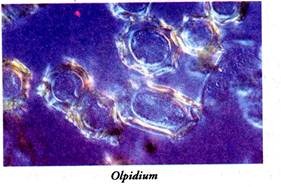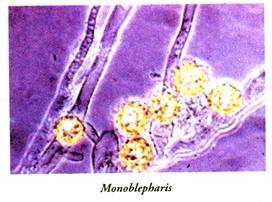ADVERTISEMENTS:
In this article we will discuss about the general characteristics of chytridiomycetes.
The chief characteristic feature of this class is the production of uniflagellate reproductive cells (zoospores and planogametes). The single flagellum is of a whiplash type and is inserted posteriorly. The zoospore with a posteriorly inserted flagellum is called opisthocont.
The flagellum is attached to the blepharoplast within the cell. The motile cells of some species possess a nuclear cap which consists of RNA. It shields the nucleus at the anterior end of the cell. Majority of the members occur in water.
ADVERTISEMENTS:
Some are found in the soil. Many are parasitic on higher plants of economic value. The primitive members of this class are microscopic. The vegetative body in them is an acellular, coenocytic thallus (Fig. 4.1 A) which is holocarpic.
It has no cell wall in the earlier stages (Olpidium). In the more advanced species, the unicellular thallus is drawn out at one point into fine, branching hairs (Fig. 4.1 B), the so-called rhizoids which aid in anchorage and intake of nutrients (Rhizophidium). In slightly more complex members, there is a much branched rhizomycelium (Fig. 4.1 C). They are eucarpic.
ADVERTISEMENTS:
In still more advanced types, a scanty mycelium consisting of a few short filamentous hyphae is in evidence. The advanced members have a mycelium consisting of typical hyphae woven into a eucarpic mycelial meshwork (Monoblepharis).
The hyphe are coenocytic. Chitin is the chief constituent of the cell of hyphal wall. Besides, there is B glucan. The septa ordinarily remain suppressed during the vegetative phase but appear to delimit reproductive organs and are solid plates.
The asexual reproductive organs are the sporangia, each of which produces numerous tiny, uninucelate and uniflagellate opisthocont zoospores. The liberated zoospores swim for a time. Later each retracts its flagellum and undergoes encystment. After a short period of rest, the encysted spore germinates. The sexual reproduction may be isogamous or anisogamous. In some it is typically oogamous (Monoblepharidales).




